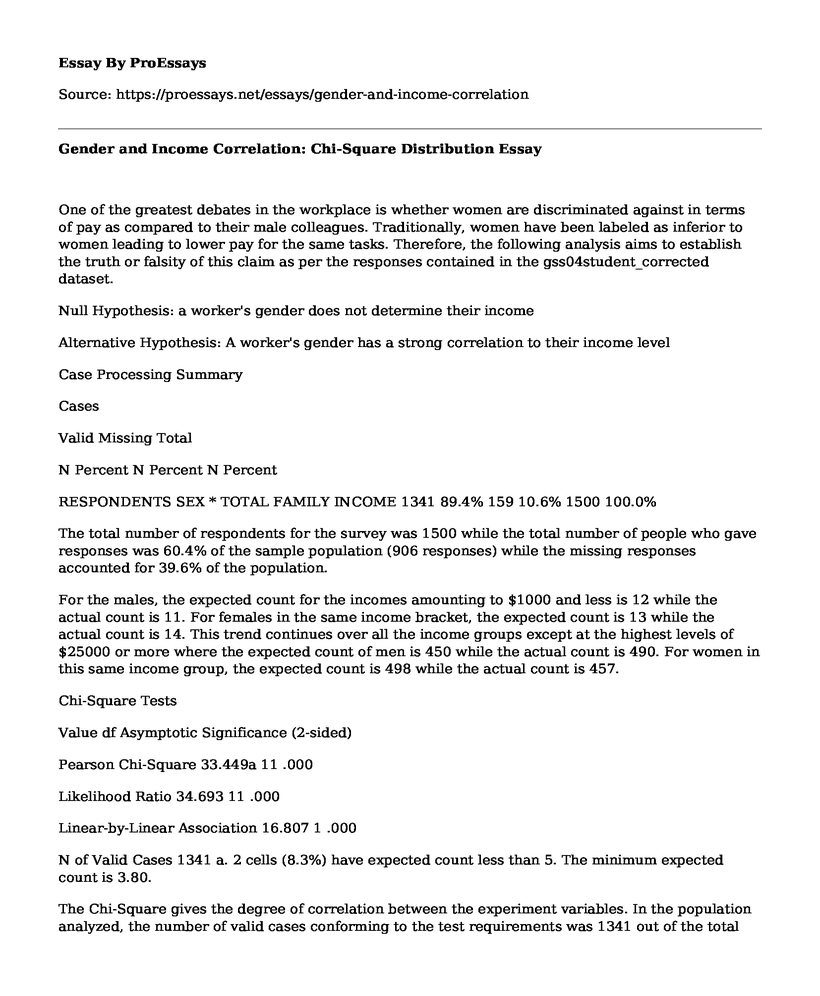One of the greatest debates in the workplace is whether women are discriminated against in terms of pay as compared to their male colleagues. Traditionally, women have been labeled as inferior to women leading to lower pay for the same tasks. Therefore, the following analysis aims to establish the truth or falsity of this claim as per the responses contained in the gss04student_corrected dataset.
Null Hypothesis: a worker's gender does not determine their income
Alternative Hypothesis: A worker's gender has a strong correlation to their income level
Case Processing Summary
Cases
Valid Missing Total
N Percent N Percent N Percent
RESPONDENTS SEX * TOTAL FAMILY INCOME 1341 89.4% 159 10.6% 1500 100.0%
The total number of respondents for the survey was 1500 while the total number of people who gave responses was 60.4% of the sample population (906 responses) while the missing responses accounted for 39.6% of the population.
For the males, the expected count for the incomes amounting to $1000 and less is 12 while the actual count is 11. For females in the same income bracket, the expected count is 13 while the actual count is 14. This trend continues over all the income groups except at the highest levels of $25000 or more where the expected count of men is 450 while the actual count is 490. For women in this same income group, the expected count is 498 while the actual count is 457.
Chi-Square Tests
Value df Asymptotic Significance (2-sided)
Pearson Chi-Square 33.449a 11 .000
Likelihood Ratio 34.693 11 .000
Linear-by-Linear Association 16.807 1 .000
N of Valid Cases 1341 a. 2 cells (8.3%) have expected count less than 5. The minimum expected count is 3.80.
The Chi-Square gives the degree of correlation between the experiment variables. In the population analyzed, the number of valid cases conforming to the test requirements was 1341 out of the total 1500 while only 8.3% had an expected count of less than 5 while the expected minimum count for each income bracket was 4 people. As shown above, the Pearson chi-square asymptotic significance value is .000 which shows that there is no significant correlation between gender and income.
Symmetric Measures
Value Approximate Significance
Nominal by Nominal Phi .158 .000
Cramer's V .158 .000
N of Valid Cases 1341 The nominal Phi and Cramers V measure the strength of correlation between variables. Phi is influenced by the strength of the relationship in addition to the sample size. To eliminate sample size effects, it divides chi-square by the sample size. Crammers V, on the other hand, is popular because it gives good values ranging from 0 to 1 regardless of the sample size. In the analysis above, both measures give a value of .158 which shows a low correlation between the variables. Therefore, there is little to no correlation between gender and income between the sample population analyzed. We accept the null hypothesis that a worker's gender has no relationship with the expected and actual income. Reference
Lancaster, H. O., & Seneta, E. (2005). ChiSquare Distribution. John Wiley & Sons, Ltd.
Cite this page
Gender and Income Correlation: Chi-Square Distribution. (2021, Mar 14). Retrieved from https://proessays.net/essays/gender-and-income-correlation
If you are the original author of this essay and no longer wish to have it published on the ProEssays website, please click below to request its removal:
- Essay on Schools and Society
- Gender Gap Essay Example
- Paper Example on Preventive Measures Against Damaging Conflicts in a Relationship
- A Raisin in the Sun: Compare and Contrast Essays
- The Influence of Social Media on Teen's Self Esteem Paper Example
- Essay Sample on What Makes an American: Exploring Beyond Citizenship
- Essay Sample on Latino Immigrants: Evidence, Images and Press Views







